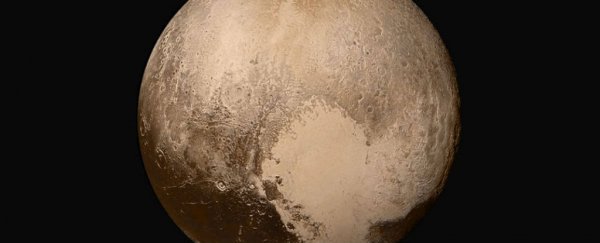It might have been demoted from planet to dwarf planet some 10 years ago, but Pluto has remained firmly in our hearts ever since. With its lonely postcode on the frosty edges of the Solar System, and that Carebear belly that couldn't be more adorable if it tried, no matter how you classify it, Pluto's just too awesome to fade into obscurity.
The latest example of Pluto's awesomeness comes from newly analysed data sent back from the New Horizons flyby, which revealed that its interactions with solar wind are entirely unique in the Solar System. "This is a type of interaction we've never seen before anywhere in our Solar System," said one of the team, astrophysicist David J. McComas from Princeton University. "The results are astonishing."
Not only are these interactions unlike anything astronomers have observed in the Solar System, they've been described as more characteristic of a planet like Mars or Venus than a dwarf planet or a comet - something that astronomers weren't exactly ready for.
Every second of every day, the Sun fires out plasma 'winds' of highly charged particles in the Solar System at speeds of around 160 million km/h (100 million mph).
The way these particles interact with the atmospheres surrounding our various planets, dwarf planets, moons, and comets can tell us a whole lot about the composition of gas that envelope these cosmic bodies, as well as the gravitational pull they're able to maintain.
For example, as solar winds approach a comet, they'd be gently slowed down over a long distance, and the very subtle influence that the comet's gravitational pull has on these charged particles would only be seen very close to the comet.
When solar winds interact with a planet like Mars, on the other hand, its strong gravitational pull exerts its influence on solar particles long before they arrive in its atmosphere.
Because Pluto has shown signs of being more like a dwarf planet or comet than an actual planet, scientists assumed that its gravitational pull would exert little influence on solar wind, but the latest batch of data analysed from the 2015 New Horizons flyby has revealed a very different reality.
When solar particles approach Pluto, they're greatly affected by its gravitational pull, like a planet, but only for short distances near its icy surface, like a comet.
"The dwarf planet was found to only interfere with the solar wind just 1,844 miles [2,967 km] in front of the body," James Maynard reports for Tech Times. "This is roughly the distance between Chicago and Los Angeles.
So basically, Pluto is a hybrid dwarf planet-comet-planet… thing, and no one's quite sure what to make of it.
"This is an intermediate interaction, a completely new type. It's not comet-like, and it's not planet-like. It's in-between," says McComas. "We've now visited all nine of the classical planets and examined all their solar wind interactions, and we've never seen anything like this."
The results have been published in the Journal of Geophysical Research - Space Physics, and show just how special Pluto really is. Whether it's a 'proper' planet or not is kind of beside the point - these results have shown that it's its own thing now, and that's arguably even cooler.
"These results speak to the power of exploration. Once again we've gone to a new kind of place and found ourselves discovering entirely new kinds of expressions in nature," said New Horizons principal investigator, Alan Stern. "Many people were surprised by Pluto's complex geology and atmosphere. This paper shows there's even more that's surprising there, including its atmosphere-solar wind interaction."
ILU Pluto. Keep doing you.
